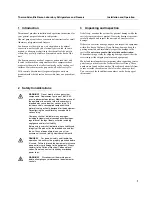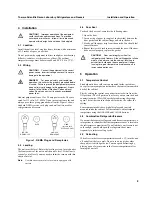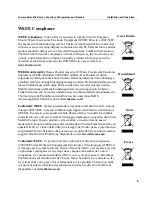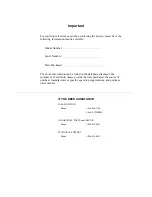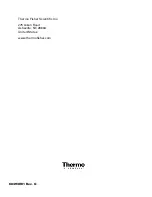
4
Thermo Scientific Revco Laboratory Refrigerators and Freezers
Installation and Operation
8
Flammable Storage Units
Units rated for flammable storage have no electrical sparking
devices, relays, switches, thermostats, etc. inside the cabinet that
could ignite flammable vapors. They cannot be placed in a room
containing explosive vapors, but chemicals that exude explosive
vapors can be safely stored inside the cabinets.
Cold controls for flammable storage units are located on the left
side of the junction box in back of the cabinet.
8.1
Safety and Usage Standards
Flammable storage units are designed to meet requirements for
Class I, Division 2 storage of flammable liquids in accordance
with the following standards:
•
UL 471 (Commercial Refrigeration)
•
NFPA 70, Sections 500 and 501 (National Electrical Code)
•
NFPA 99, Section 10 (Health Care Facilities)
•
NFPA 45, Section 9 (Laboratory Fire Protection)
•
NFPA 497A (Defines Class I locations)
It is the user's responsibility to follow the guidelines set forth in
the codes listed above. Class I, Division 1, Groups C and D
combustible material may be stored inside the cabinet but the
cabinet itself is not approved for Class I, Division 1 locations.
Some important guidelines:
•
Do not place the unit near Bunsen burners, hot plates, ovens
or any other sources of ignition.
•
Be sure to store flammable liquids in appropriate containers
according to the standard NFPA 30.
•
Do not exceed the maximum storage quantity, 60 gallons per
5000 sq. ft. of floor space.
WARNING!
Refrigeration components are very
susceptible to damage due to the introduction of
caustic and acidic materials. The manufacturer will not
be liable for damage to or loss of contents, or for
damage to the following construction materials:
Copper, aluminum, steel, ABS, polystyrene, polystyrol,
zinc, lacquer coating, silicone
sealants, epoxy, polyurethane, vinyl, and PVC.
See written manufacturer’s warranty for details and
further limitations.
Be sure that your unit is level and that the floor can properly
support the weight of the unit and contents fully loaded.
8.2
Electrical Requirements
A properly grounded electrical receptacle must be installed to
service this unit. The minimum wire size is 12 AWG. A circuit
breaker or time delay fuse may be sized in accordance with the
full load current stated on the unit nameplate, but in no instance,
more than 15 amps.
9
Explosion-Proof Units
Units rated UL explosion-proof have hermetically sealed
compressors with all operating components sealed against
entrance of explosive vapors. Electrical junction boxes are also
sealed after connections are made.
Cold controls for explosion-proof units are located in back of the
cabinet behind the junction box cover (see Figure 2 on page 5).
9.1
Safety and Usage Standards
Explosion-proof units are approved for use in Class I, Division 1
locations, defined in the standard NFPA 497A.
These units are similar in design to flammable storage units and
may be used for storage of flammable liquids.
If you are using your unit to store flammable liquids, be sure to
read Section 8.1 carefully and review the appropriate
standards.
9.2
Electrical Requirements
Explosion-proof units must be installed electrically using rigid
metal conduit having threaded fittings with at least five full
threads engagement and internal sealing within 18" of any
enclosure containing sparking devices. The user must supply
and install a disconnect switch or circuit breaker suitable for
hazardous locations within sight of the unit.
When installing power supply, use 14 gauge wire with 1/16"
insulation, and three conductors, one of which is a ground.
Mix all of the sealing compound and packing fiber supplied with
the unit. Mix the compound in proportion by volume, 1 part
water to 3 parts powder.
Figure 2 on page 5 shows field wiring connections. Using an
additional junction box, while not required by national and local
codes, provides the best method in case the unit will be moved at
any time in the future. Using this method, field connections will
be made up in a reusable enclosure and all wires and sealing
fitting will be retained intact. If desired, the second junction box
can be eliminated and wire connections made up within the
sealing fitting and then filled with the sealing compound.




